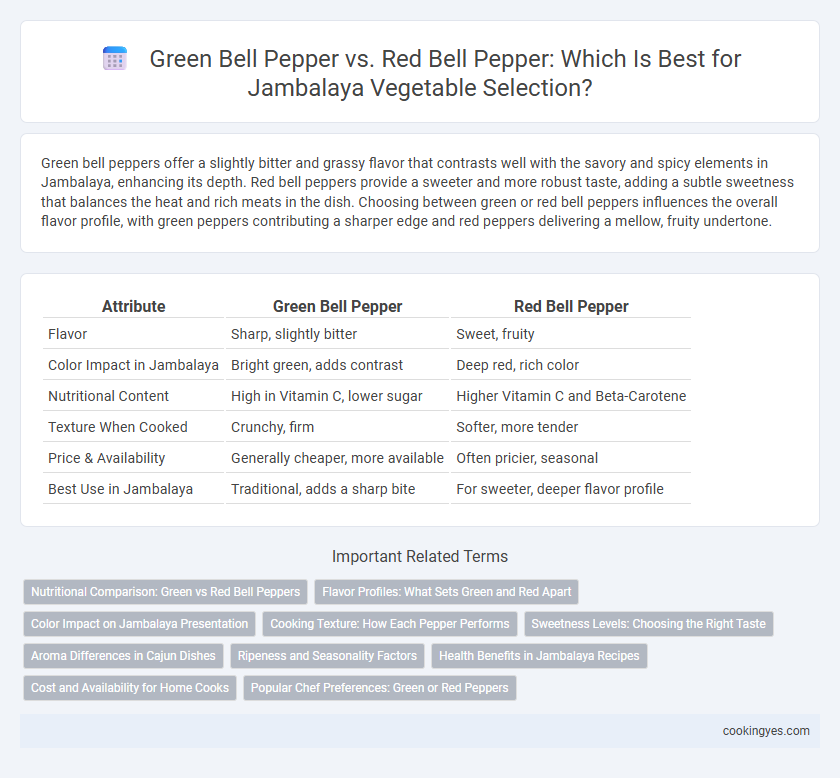Green bell peppers offer a slightly bitter and grassy flavor that contrasts well with the savory and spicy elements in Jambalaya, enhancing its depth. Red bell peppers provide a sweeter and more robust taste, adding a subtle sweetness that balances the heat and rich meats in the dish. Choosing between green or red bell peppers influences the overall flavor profile, with green peppers contributing a sharper edge and red peppers delivering a mellow, fruity undertone.
Table of Comparison
| Attribute | Green Bell Pepper | Red Bell Pepper |
|---|---|---|
| Flavor | Sharp, slightly bitter | Sweet, fruity |
| Color Impact in Jambalaya | Bright green, adds contrast | Deep red, rich color |
| Nutritional Content | High in Vitamin C, lower sugar | Higher Vitamin C and Beta-Carotene |
| Texture When Cooked | Crunchy, firm | Softer, more tender |
| Price & Availability | Generally cheaper, more available | Often pricier, seasonal |
| Best Use in Jambalaya | Traditional, adds a sharp bite | For sweeter, deeper flavor profile |
Nutritional Comparison: Green vs Red Bell Peppers
Green bell peppers provide a slightly higher vitamin K content, essential for blood clotting and bone health. Red bell peppers contain significantly more vitamin C and beta-carotene, boosting immune function and eye health. Both peppers offer dietary fiber and antioxidants, but the red variety delivers greater overall nutritional benefits.
Flavor Profiles: What Sets Green and Red Apart
Green bell peppers have a slightly bitter and grassy flavor that adds a sharp, fresh contrast to jambalaya's rich spices, while red bell peppers offer a sweeter, fruitier taste that enhances the dish's overall depth and complexity. The choice between green and red bell peppers influences the balance of flavors, with green contributing a more pronounced vegetal bite and red providing a mellow, sweet undertone. Selecting the pepper color impacts the jambalaya's aromatic profile, affecting how the spices and ingredients harmonize in the final dish.
Color Impact on Jambalaya Presentation
Green bell peppers add a vibrant, earthy contrast to jambalaya, enhancing its visual appeal with a fresh, crisp hue that complements the dish's rich spices and meats. Red bell peppers bring a sweeter flavor profile and a bold, warm color that intensifies the overall presentation, making the dish look more appetizing and festive. Choosing between green and red bell peppers impacts not only the taste but also the aesthetic balance, with green providing a more traditional look and red adding a modern, colorful twist.
Cooking Texture: How Each Pepper Performs
Green bell peppers offer a firmer texture that holds up well during the extended simmering of jambalaya, providing a slight crunch that contrasts with the softer ingredients. Red bell peppers become tender and slightly sweeter as they cook, blending smoothly into the dish and enhancing its overall flavor profile. Choosing green peppers emphasizes texture retention, while red peppers contribute a softer consistency and depth of sweetness in jambalaya.
Sweetness Levels: Choosing the Right Taste
Green bell peppers offer a slightly bitter and grassy flavor, providing a crunchy texture that balances spicy and savory elements in jambalaya. Red bell peppers are sweeter and milder due to longer ripening, enhancing the dish with a rich, fruity undertone. Selecting green peppers emphasizes traditional zest, while red peppers add a natural sweetness that complements smoky spices.
Aroma Differences in Cajun Dishes
Green bell peppers provide a sharper, more grassy aroma that complements the bold spices in Cajun jambalaya, while red bell peppers offer a sweeter, fruitier scent that can mellow the dish's intensity. The choice between green and red bell peppers influences the overall fragrance profile, with green enhancing earthier, piquant notes and red contributing a subtle sweetness. Chefs often select green bell peppers for authentic jambalaya to maintain its traditional aromatic balance characteristic of Louisiana cuisine.
Ripeness and Seasonality Factors
Green bell peppers are harvested earlier in the growing season, resulting in a firmer texture and slightly bitter, grassy flavor ideal for traditional jambalaya recipes that require sustained cooking. Red bell peppers, being fully ripened, offer a sweeter, more complex taste and higher vitamin C content, enhancing the overall flavor profile when added closer to the end of cooking. Seasonal availability varies, with green bell peppers often appearing earlier in spring and red bell peppers peaking later in summer to early fall, influencing local ingredient selection for authentic jambalaya preparation.
Health Benefits in Jambalaya Recipes
Green bell peppers in jambalaya provide a crisp texture and a slightly bitter flavor, rich in vitamin C and antioxidants that support immune health. Red bell peppers, sweeter and more vibrant, contain higher levels of beta-carotene and vitamin A, promoting eye health and reducing inflammation. Choosing between green and red bell peppers influences both the nutritional profile and flavor complexity of jambalaya recipes.
Cost and Availability for Home Cooks
Green bell peppers are generally more affordable and widely available year-round in most grocery stores, making them a cost-effective choice for home cooks preparing jambalaya. Red bell peppers tend to be more expensive due to their longer growing period and slightly seasonal availability, which can impact budget-conscious meal planning. For a flavorful yet economical jambalaya, prioritizing green bell peppers ensures consistent access without compromising the dish's essential taste profile.
Popular Chef Preferences: Green or Red Peppers
Popular chefs often choose green bell peppers for jambalaya due to their slightly bitter, robust flavor that complements the dish's spicy and savory profile. Red bell peppers, being sweeter and less intense, are favored when a milder, more balanced vegetable note is desired. The choice between green and red peppers directly influences the jambalaya's overall taste complexity and authenticity.
Green bell pepper vs Red bell pepper for vegetable selection Infographic

 cookingyes.com
cookingyes.com